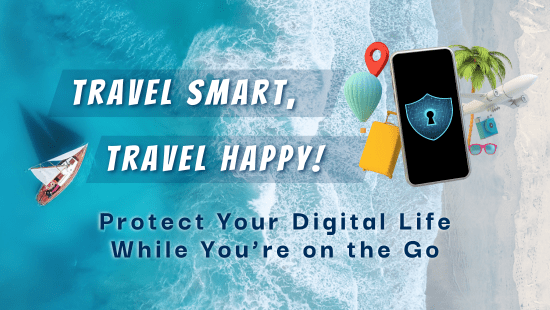Whether you’re headed to a tropical beach, the mountains, or just taking a well-deserved staycation, stepping away from work should bring peace—not digital problems. Unfortunately, cyber threats don’t take vacations. In fact, they often ramp up when you let your guard down.
At My Computer Guy, we believe that good cybersecurity habits should travel with you. So while you’re packing your bags, don’t forget to prepare your digital devices and online presence, too. Below are smart cybersecurity practices to follow before, during, and even after your trip to help protect your data, identity, and peace of mind.
Update and Secure Your Devices Before You Leave
Think of this as your cybersecurity pre-flight checklist. Before you head out the door:
Install Updates: Make sure all your devices—laptops, tablets, smartphones, smartwatches—are fully updated with the latest software patches. These updates often include security fixes for vulnerabilities hackers are actively trying to exploit.
Use Strong Authentication: Secure your devices with complex passwords, PINs, or biometric features like fingerprint or facial recognition. Consider using a password manager to generate and store strong credentials.
Enable Remote Tracking and Wipe: If your phone or laptop gets lost or stolen, remote tracking features like Apple’s “Find My” or Google’s “Find My Device” can help you locate it. You can also remotely wipe your data if the device falls into the wrong hands.
Secure Your Home Network While You’re Away
Yes, you’re not using it while you’re gone—but cybercriminals might try to.
Change Default Router Passwords: If you haven’t already changed the default login credentials for your Wi-Fi router, now’s the time. Hackers often scan for unsecured routers as an easy access point.
Use Strong Encryption: Make sure your network is using WPA3 encryption, or at the very least WPA2.
Disable Remote Access: Unless absolutely necessary, turn off remote management features that could allow someone to tamper with your home router while you’re away.
Set Up a Guest Network: If someone needs access to your internet while you’re away—like a pet sitter—provide a guest network rather than your main one. This keeps your personal devices isolated.
Think Twice About Public Wi-Fi
Airports, hotels, coffee shops—all known for their sketchy Wi-Fi networks. Free doesn’t mean safe.
Avoid Logging into Sensitive Accounts: Don’t check your bank account or access sensitive work files over public Wi-Fi unless absolutely necessary.
Use a VPN (Virtual Private Network): A VPN encrypts your internet traffic, shielding it from hackers on the same network. It’s a must-have when using public connections.
Disable Auto-Connect: Make sure your phone or laptop doesn’t automatically connect to any available Wi-Fi. This can expose your device to malicious networks.
Watch Out for Phishing Attacks
Cybercriminals love targeting travelers. You’re relaxed, you’re distracted, and you might not question a suspicious message.
Don’t Click on Strange Links: Be skeptical of emails, texts, or social media messages urging you to click a link or download an attachment—especially if it looks like it’s from your bank, airline, or a delivery company.
Verify Sources: If you receive a message that looks real but seems urgent, contact the company directly using a known phone number or website—not the info in the message.
Use Multi-Factor Authentication (MFA): If someone gets your password, MFA can be the extra layer that keeps your account safe.
Limit Social Media Sharing
We get it—you’re having the time of your life and want to share it. But oversharing can create real risks.
Don’t Broadcast Your Absence: Posting your real-time location lets would-be burglars know your house is empty.
Save the Sharing for Later: Consider posting those dreamy beach pics after you get home.
Lock Down Your Privacy Settings: Make sure your posts are only visible to trusted friends or family, not the public.
Turn Off Auto-Connect and Bluetooth
Auto-connect and Bluetooth features are convenient—but they can also be entry points for hackers.
Disable Auto-Connect: Prevent your devices from automatically joining unknown Wi-Fi networks.
Turn Off Bluetooth When Not in Use: Bluetooth signals can be intercepted or used in certain types of cyberattacks, especially in crowded public places like airports.
Physically Protect Your Devices and Documents
Not all threats are digital —it’s physical, too.
Use Hotel Safes: Store your passport, travel itinerary, and any backup drives or devices in a locked safe.
Don’t Leave Devices Unattended: Whether you’re at a café or charging your phone in a hotel lobby, always keep a close eye on your gear.
Beware of Juice Jacking: Avoid plugging your devices into public USB charging ports. Use a power-only charging cable or your own wall adapter.
Monitor Your Accounts and Activity
Even if you follow all the tips above, it’s good to stay proactive.
Check Financial Statements: Look for suspicious charges and unusual activity in your bank or credit card accounts while you’re away and when you return.
Set Up Account Alerts: Most financial institutions let you set up alerts for transactions, login attempts, and password changes. Enable these for real-time security updates.
Run a Post-Trip Device Check: After you return, consider doing a quick security scan on your devices and updating any passwords you used while traveling.
Final Thoughts: A Little Preparation Goes a Long Way
Vacations are meant to be relaxing, but there’s nothing relaxing about a hacked account or stolen identity. With just a little extra effort before and during your trip, you can protect your personal information, devices, and home—giving you true peace of mind wherever you go.
Safe travels—and stay secure out there!




